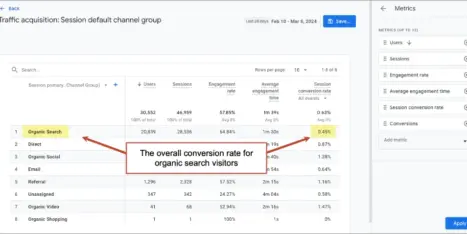Everyone knows the term “content strategy.” Nothing earth shattering there, but how does the average small business owner implement a content strategy?
What channels should you be using or which ones can you skip? What resources should you be dedicating to your content strategy? How do you measure results?
I’ve asked the best and brightest content marketers to answer a few of these questions. Let’s meet the experts and see what they have to say.
 |
Mark Schaefer, Chieftain of the blog {grow}. Consultant, educator, author of Return On Influence, Born to Blog, Tao of Twitter & Social Media Explained, @markwschaefer |
 |
Ross Hudgens, Founder of Siege Media, @RossHudgens |
 |
Deana Goldasich, Content Marketing Monster and CEO of Well Planned Web, @goldasich |
 |
Arnie Kuenn, CEO of Vertical Measures. Frequent speaker. Author of Accelerate!, @ArnieK |
 |
Amanda Maksymiw, Content Marketing Manager at Lattice Engines, @amandamaks |
 |
Kevin Cain, Content marketing and communications strategist Kevinrcain.com, @kevinrcain |
1. Not everyone does audience research and personas. Is this a mistake?
Mark Schaefer:
The obvious answer would be “yes” but I think it is more subtle than that. Here is an example of what I mean.
I was in a client meeting with a company CMO and their ad agency. The agency was walking them through a painstaking process of persona development that was now in its third hour. The CMO became more and more agitated. Finally, she lost it.
“I’ve worked in this industry for 20 years,” she said. “I’ve done every kind of sales, service and marketing job in this company. Why do I need to create these personas? I know our customers better than anyone. I know how to communicate to these folks.”
I think she had a point. Undoubtedly there is a role for personas, but they can also be over-used. I think there is something to be said about a human connection based on real experience and emotion versus scripted communications aimed at what we think people want to hear.
Perhaps an unconventional answer, but based on real life experiences. : )
Ross Hudgens:
It’s definitely a mistake, but not a critical one. There are thousands of successful businesses doing good marketing without personas in place, but that doesn’t mean they couldn’t be doing even better if they developed personas to help round out their strategy.
Deana Goldasich:
Audience profiles are so critical. We won’t work with clients unless they agree to them as a first step. When done correctly, audience profiles serve as a “content GPS” — steering teams away from broad-based content that delivers “fluff” leads and driving towards focused content that that is more likely to deliver *qualified* leads.
Segmenting your content by audience is becoming especially important with the flood of information available today. Profiles must never be seen as an “exercise.” They must become the content-mapping and accountability “bible” by which all marketers abide.
Arnie Kuenn:
Not at all. Some very successful marketers do very well without detailed personas. Sometimes I think a heavy focus on personas in the beginning — the detailed spreadsheets, persona maps, etc. — is a little too much.
Of course it can be very helpful and essential as you go along, but don’t forget about actually producing the content. Do enough research to get started, have an idea of who your target customer is, and then jump right in. You can always improve and hone your ideas as you go along and discover more about your audience.
Amanda Maksymiw:
Yes, it’s a mistake to not do any type of research. Otherwise, you’re creating content in a vacuum without having any assurance that the content you are creating is valuable and relevant for your audience.
It’s not necessary to spend thousands of dollars and hundreds of hours researching and building personas, but all content marketers should do some type of research. Talk to your people on your sales, product or customer team within your company and a few customers and prospects if you are resource-constrained. Ultimately you want to learn the top challenges, opportunities, interests, and preferences of your audience and that can be accomplished with a little bit of research.
Kevin Cain:
Yes, and it can be a costly one. The fact is that even when you understand your audience it’s difficult to create content that’s not only able to cut through the noise, but that also gets people to take action. It becomes virtually impossible to do so (at least with any consistency) if you don’t know who they are, what they care about, what their pain points are, and where in the buying process they are getting hung up or stuck. Fail to take the time to understand your audience, and you risk wasting a lot time and money developing content that doesn’t drive results.
The best way to learn is by doing.
Once you have some initial ideas about your audience, start creating content and see what happens. The insights you gather from this experience (what worked well? what didn’t?) will help you further shape your understanding of your audience and improve your content. Additional research and persona development will help sharpen your approach over time.
2. How do you balance promotion channels (search, social, email)? Are these common to every strategy?
Mark Schaefer:
I don’t think there is anything like a common strategy in this business! The right balance has to be determined by the competitive pressures in your industry, the needs of your customers, and the strengths of your resources.
I also think we need to have a very rational view of the role of digital in the mix. Remember that marketing is much, much more than search or a Facebook page.
I worked with one company for two years on other marketing fundamentals (like CRM and customer research) before we embarked on social or email. In another company, we had to work on re-vamping a service department as a priority before they could even think about anything else.
In my own business, honestly, there is a lot of trial and error. I get a lot of my leads through the blog, so obviously that is an emphasis.
Ross Hudgens:
It’s definitely a client-by-client kind of implementation. As a general practice I’d say a good strategy finds ways to utilize content that can be used in a variety of ways (without being out of place on a given network).
For example, you might create a great blog post (optimized for search) that goes out in a top 10 newsletter of the industries best work (such as the Moz Top 10), while also creating a unique Facebook image to promote it to give it better visibility on that network. The more content that can live cross-platform the more potential ROI you’ll likely have.
Deana Goldasich:
With an abundance of content out there, content leaders should expect to spend an equal amount of time on distribution and sharing as they do on creation. Content strategists must map each piece of content to relevant groups, conversations hashtags, boards and communities. Too often, they simply broadcast to a few networks and move on.
The savviest strategists are those who dig, forage and casually introduce their content into existing conversations.
This can happen over a period of weeks or even months. We find that we continue to see residual traffic for our clients on conversations and comments that are years old.
Arnie Kuenn:
The thing to remember in the convergence of search, social, email (and any other element you can think of) is: you may not be able to do it all.
Maybe your business only has the bandwidth for a blog post a week and social distribution, but email is another beast you haven’t gone into yet. That’s okay.
In an ideal world (and in the most successful strategies), each element works together as an integrated whole. Even if you can’t tackle email marketing now, start planning ahead for when the opportunities arise to push forward and add another tool to your arsenal. The more integrated you are with multiple touch points, the more success you will see.
Amanda Maksymiw:
Search, social and email are all important to us. Search and social help us to get in front of audiences we may not currently be engaging with on other channels. We also use social to help test and tweak our messaging on a more rapid basis. Email helps us stay in contact with our database on a regular cadence.
Kevin Cain:
Here again, it comes down to understanding your audience. If you’re targeting people who aren’t active on Pinterest, for example, clearly that’s not a good channel for you to focus on.
Other factors to consider are how much bandwidth you have to take things on and what your time horizon is. Search is critically important for getting your content discovered, but unless you’re paying for it, it’s a long-term play.
As you’re developing your strategy, the best approach to take is to be consistent and to devote whatever resources you have available wherever you think they will have the greatest impact. Remember, it’s much better to go deep on one channel that works well than to spread yourself too thin across many that aren’t as effective.
3. What kind of time, money, resource challenges do you typically face? How do you deal with this?
Mark Schaefer:
Yes. : )
In general, business is about prioritizing isn’t it? I work with a fast-growing company who doesn’t add any people or resources until it “hurts.” I think that is the right way to think about it.
It can be frustrating — so much opportunity — but I think one of my strengths is discipline and focus. My priorities are consulting, content, and my college classes. That’s what brings in the revenue. If it doesn’t fit one of those categories, I either don’t do it or out-source the activity.
My biggest challenge is time. As a small company, I don’t have much room for error. Any commitment I make can have big consequences for the financials. So have to be discerning and learn how to say no.
Ross Hudgens:
There are always challenges depending on the type of project. The biggest challenge we generally face is getting our content ideas to match the KPIs of the internal teams that hire us to sync up with the internal teams that don’t.
Sometimes creative teams are very adamant about a certain content “voice” or structure which can sometimes make our core goals impossible unless there’s some give and take. We’re not perfect either and sometimes getting to know a brand can take time, but it can sometimes elongate the approval process longer than we’d normally like.
We deal with this by pitching lots of ideas, getting as much brand information as possible up front (such as personas/branding documents), and also getting to know the needs/history of the teams that are likely to approve or deny our ideas. Sometimes we’ll take a short-term step away from our needed KPIs to make the teams across the organization look good so we can better accomplish our goals in the long run.
Good content marketing makes everyone look good, so we find that somewhat strict internal teams at the beginning of a campaign will normally open up as we have success over time. Of course, that is likely also to do with us getting to know the brand identity/pitching better ideas over time.
Deana Goldasich:
We’re finding more and more companies need to re-focus their content efforts. Quite often, they’re feeding the content beast diligently — but not taking a close look at its diet.
Is the content nutritionally sound (truly addressing audience needs)? Or, are there a lot of “empty calories” in the mix?
Arnie Kuenn:
Time, money, and internal resources will always be a challenge. Especially if you’re working hard in the day to day of actually running your business, sometimes content marketing can fall to the side. But, it’s important to remember marketing your business is the way you keep your business running!
The best way to deal with this is planning.
When you plan ahead (far ahead and minute details), you are more able to deal with the daily work involved, including the appropriation of internal resources, budget, and time that needs to be devoted to each step of the process.
Planning also helps diminish last minute surprises and mad dashes to the finish line. Save yourself the headache and carve out some precious time to plan out your roadmap (or calendar). You’ll be thankful you did so.
Amanda Maksymiw:
A lot of my experience has been in the tech startup space, so I haven’t met a marketer who isn’t resource constrained! I know I have faced the challenges of not having enough time, money or headcount to get various projects done.
You have to be really diligent and focused when it comes to prioritizing what work or projects to tackle and not be afraid to say no. I think the best advice I’ve ever heard is that the to-do list is never fully cleared so just focus on getting the most important work done and move on.
Kevin Cain:
There’s never enough time or money to do everything that you want to. The solution is that you have to find ways to work smarter.
Refine and systemize your processes, think strategically about how to get the greatest ROI from every piece of content that you create (the old model of “one and done” just doesn’t fly anymore), and learn from your mistakes. When you do, you’ll find yourself becoming more efficient and able to accomplish more in less time and for less money.
4. Where do your ideas for content typically come from? Ever run low?
Mark Schaefer:
Whenever I write a great post, invariably somebody in the comment section will write “I was thinking the same thing. I think one key to great content is having that nose for news and having the courage to put yourself out there and say the things most people are just thinking about.
I also think “discipline” is another key word when it comes to content. You have to constantly gather ideas, set aside time to write every week, spend the time to edit, re-write, make it great.
The ideas are everywhere. I get so many post ideas from conversations, blog comments, LinkedIn groups, and questions from students.
I’ve only felt my content ideas running dry one time in five years and that is because I had gotten sloppy and had not been deliberate about collecting ideas. The ideas are out there. You just have to think in terms of blog posts as you go about your life.
Ross Hudgens:
Ideas come from everywhere. Competitive research, keyword research, other successful content in adjacent verticals, walks, colleagues, friends, my fiancé. It can definitely be a challenge as we are often slated with building “big” content that has to knock it out of the park.
A blog post is easy, making sure a client gets ROI on content they spend a lot of money on is not.
We are constantly on the search for “templates” – posts we know do extremely well that we can keep doing. These don’t always work and they can definitely dry up, but there is definite potential for repeated quality, such as with Moz’s Whiteboard Friday.
Deana Goldasich:
At the risk of sounding like a broken record 🙂 — When audience profiles are done right, you should literally have several year’s worth of content right out of the gate. And, of course, every case study, white paper or report usually reveals multiple other content ideas.
Our challenge is never running low. It’s prioritizing what we have.
Arnie Kuenn:
To be honest, I can’t tell you a time when we have run low on ideas at Vertical Measures. That is in part because of our culture – every person from an SEO specialist to a PPC manager knows that any moment in their work day or conversations with their clients lies an opportunity for content. Make sure your people know how to mine their own day for ideas and this will give you a plethora of highly relevant, informed content.
If we did run low, we have a process in place for researching ideas, something I’ve outlined numerous times in my in-person workshops to great surprise and delight by attendees. Google is your best friend in this case, so I recommend utilizing it to your advantage.
Amanda Maksymiw:
It’s a combination of a lot of different sources – things overheard in meetings, conversations with coworkers, looking for inspiration from companies outside of our space, conversations with customers. I try to always carry around a notebook (I’m old school) to jot down ideas as they pop up to ensure I always have a running list of topics or content ideas to create.
Kevin Cain:
I get my ideas from reading and by watching and listening to what others are doing. Every interaction you have with a good piece of content should help spark new ideas for your own content.
I think everyone runs low on ideas from time to time, and that’s why it’s important to regularly get a change of scenery. Go investigate new websites, blogs, books, videos, etc., that you haven’t seen before, to get some fresh inspiration.
5. What’s your favorite measurement? How often do you watch it?
Mark Schaefer:
I am fairly obsessed with metrics. I am constantly watching the blog traffic — several times a day — because it can be a signal of something else going on. For example, a spike might indicate that the content has been shared in a special way or syndicated. An unusual source for the traffic might mean my post has been referenced somewhere else. A lot of new traffic from an old post is an interesting thing to look at.
The traffic numbers can be an indicator of other things. In the long term, the only metric that matters to me are returning visitors to the site. If that number is going up, I am doing good work.
Ross Hudgens:
My favorite measurement is sales/conversions, of course. 😉 But unfortunately we don’t always have access to that for a client, so we generally settle for second best sources of success, like content pickup from outside publications. Watching general trends like search traffic is also a go-to as there are tools like SEMRush that allow us to monitor the success of our clients even if we don’t have direct access to Analytics.
Deana Goldasich:
I love this question! For our B2B clients, of course, we watch lead-generation numbers and lead-nurturing scores like a hawk. It is SUCH a rush to see the path that a lead travelled before he/she converted. We learn so much about what meets the prospect’s needs and what content we should continue to produce or consider.
Arnie Kuenn:
Leads. Leads. Leads. There really can be no better measurement than this, because it means we’re generating qualified and interested people who could someday become a paying customer.
If we aren’t focused on the bottom line and the ROI of all our content marketing efforts, then we’re doing something wrong. We are in this game to build relationships, offer useful content, and in the end – gain business from it all. We monitor our leads every week and adjust based on trends we see in who they are, what they’re interested in, and how far along the sale cycle they are.
Amanda Maksymiw:
I look at traffic and conversions on a near-daily basis.
Kevin Cain:
My favorite is the number of comments a piece of content gets, which is a great measurement of engagement. We all bounce across lots of different websites and pieces of content every day, but how many of them do you actually engage with so thoroughly that you feel compelled to leave a comment?
In my view, a comment is the ultimate sign that you’ve engaged your audience so successfully that they wanted to engage back with you. That’s incredibly powerful and worth a lot more than a fleeting pair of eyes on a page. I get notified of comments in real time so that I can respond to them as quickly as possible.
6. What’s the shelf life of a good content strategy? How often do you do this stuff?
Mark Schaefer:
I think strategy should be dynamic. Business moves too fast to be wedded to anything for too long.
Strategy is something that, hopefully, can be sustained, but you always need to be looking around for changes, for opportunities, for holes that are closing around you. The shelf life of a strategy is highly dependent on the industry and competitive environment.
We are in a world where not only are the platforms changing, the rules of engagement are changing too.
I think to be great at strategy today a good dose of paranoia is important!
Ross Hudgens:
Generally clients hire us and insert our content into their content strategy, so it’s not something that’s a regular part of our process. But it is a big part of our process to make sure that we fit into their content strategy.
However, a good content strategy should evolve. For most brands I can see it changing a small percentage every year, as long as it’s not completely broken it should never just “fall off the shelf” – but it should change to account for the evolution of their customer base and also the world around it.
Deana Goldasich:
A content strategy is never really “done.” It evolves, grows and morphs over time. But, it should always map directly back to those audience profiles.
We do find that we occasionally add an audience as a company grows. We may also tweak a profile here and there based on changes in a client’s industry.
Arnie Kuenn:
We are continuously looking at what works and what doesn’t thne adjusting our strategy accordingly about every 3 to 4 months. We do a major review every year, pulling together all our data to show hard facts and numbers that usually prove our hunches wrong. We then strategize our year in broad strokes and then focus more specifically on each quarter. We look at upcoming events, industry shifts, and our internal focus.
Amanda Maksymiw:
I think the overall shelf life of a content strategy is around 12-18 months. If you are changing your strategy on a quarterly basis, it may be confusing to your audience and challenging to build a real following. I typically define a strategy at the beginning of the year and check in every few months to ensure things are still on target. It’s important to remember that content strategy is a living thing and it shouldn’t be hidden away and ignored.
Kevin Cain:
A good strategy shouldn’t have a shelf life because it should be constantly evolving based on new data and metrics. Every new piece of content that you publish will generate data that can give you new insights to inform your strategy. You may not be making directional changes from week to week, but you should be making small course corrections and adjustments at least that often.
In my opinion, strategies that are too rigid to adapt and evolve with you as you learn, are going to be difficult to execute successfully over the long term.
A special thanks to all the experts who took the time to share their knowledge. THANK YOU! If you have more questions, we’d love to hear them in the comments below. If you’d like more content marketing tips, here’s 35 more.




